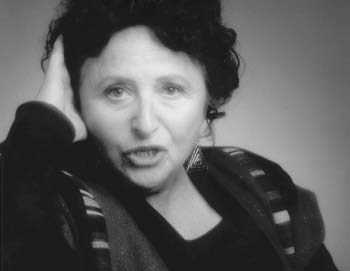![[MetroActive Stage]](/gifs/stage468.gif)
[ Stage Index | Santa Cruz | MetroActive Central | Archives ]
A World Apart
Erica Lann-Clark re-creates Yiddish culture, from Eastern Europe to the Lower East Side
By Andrea Perkins
THE PROGRAM NOTES for Erica Lann-Clark's latest performance work, Once There Was a World: From the Shtetl to the Hood, describe it as "a one-woman show about the shades of gray between what's Jewish and what's Yiddish in and out of America." While that is certainly the case, Lann-Clark's work goes beyond this modest promotional statement. Like her previous offerings, Once There Was a World is nothing less than an astonishing resuscitation of the fading art of storytelling.
This time around, Lann-Clark intertwines old Yiddish tales with the modern-day legends of her own life. The creative guidance of director Stephanie Golino and the jubilant music of Esther's Klezmer Band, a talented female quintet, deepens the stories' dramatic dimension. The way the band itself is incorporated into the storytelling is pure brilliance.
On a stage set simply with a chair, a stool, a black box and a white curtain, Lann-Clark brings her tales to life. The journey begins with a Yiddish folktale about a prodigal son who is obsessed with singing. Then, with great humor and honesty, Lann-Clark narrates her own childhood in a Jewish neighborhood in Brooklyn and her experience as a young bohemian in Manhattan, entering the world of "theater, the source bed of revolution." Sheherazade-like, Lann-Clark discovers stories within stories, seamlessly moving from her sons' run-in with Hasidic Jews to an uproarious urban legend about a Meshillach who gets reincarnated as a kugel.
Lann-Clark savors the flavor of each word, and her timing is impeccable. "This is about the inheritance," she says toward the beginning of the show, causing shivers to run up and down the spine--"the real inheritance." A diminutive dynamo with stage presence to spare, Lann-Clark has the audience in convulsions. One woman in front of me laughed so hard she fell out of her chair, and I feared for the safety of several other audience members who were having difficulty breathing after that story about the kugel.
Lann-Clark celebrates other moments in the vast history of the Jews, relishing New York Yiddish culture and its roots in Eastern Europe, shining an often-irreverent light into cobwebbed corners. During the breathtaking finale, called "The Reincarnation of a Melody," based on a tale by the Polish writer Isaac Leib Peretz, Lann-Clark tells of how a single melody was passed down through time, moving from the fiddle of a street musician, to the mouth of an orphan, to the ear of a holy man, to the Yiddish stage. Lann-Clark (and the klezmer band) manages to powerfully re-create the ambience of the latter with nothing more then words, music and a subtle infusion of red lighting.
Like the people who passed on the melody she speaks of, Lann-Clark takes up old narrative threads and gives them soul. At once preserver and innovator, her contributions not only to art but to the well-being of the community were aptly recognized; the opening night performance was attended by the mayor of Santa Cruz, who right then and there proclaimed June 1, 2001, "Once There Was a World" Day.
[ Santa Cruz | MetroActive Central | Archives ]
Copyright © Metro Publishing Inc. Maintained by Boulevards New Media.
![]()

The Story of Us: Lann-Clark's one-woman show mines the rich territory of Jewish culture.
Once There Was a World plays at 8pm, Friday and Saturday; 7pm, Sunday, through June 10, at the Actors' Theatre, 1001 Center St., Santa Cruz; $12/$15; 831.479.1874.
From the June 6-13, 2001 issue of Metro Santa Cruz.